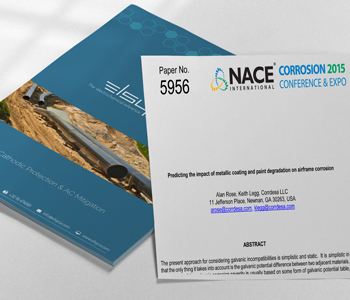
Airframe corrosion challenges
(NACE 2015)
This paper introduces a development where deterioration is simulated over time, accounting for the consumption of sacrificial metallic coatings. The insight provided by this approach is invaluable, for the first time giving the designer the tools to incorporate protection schemes that are more damage-tolerant, and appropriate for the intended operational environment of the weapons system.

Airframe corrosion challenges (Nace 2015)
Alan Rose, Keith Legg, Corrdesa LLC.
Abstract
The present approach for considering galvanic incompatibilities is simplistic and static. It is simplistic in that the only thing it takes into account is the galvanic potential difference between two adjacent materials. An estimate of the galvanic corrosion severity is usually based on some form of galvanic potential table, as in MIL-STD-889. However, in mixed material assemblies it is the galvanic current that determines the severity of corrosion, not the galvanic potential, and the two are not directly related. The design engineer needs a way to estimate the true corrosion risk based on both the explicit geometry and all the materials in an assembly.
The present approach is static in that it assumes that the condition of an assembly remains constant. However, from the moment that weapons systems are deployed, corrosion protection schemes become compromised over time due to physical and environmental damage. Sacrificial coatings and passivates become depleted, while paint systems become damaged and deteriorate. It is essential therefore, that the design engineer considers, upfront, not only how the factory-fresh finish system will perform, but the very real impact of environmental degradation and protective finish damage on the integrity of the weapon system over its lifetime.
This paper introduces a development where deterioration is simulated over time, accounting for the consumption of sacrificial metallic coatings. The insight provided by this approach is invaluable, for the first time giving the designer the tools to incorporate protection schemes that are more damage-tolerant, and appropriate for the intended operational environment of the weapons system.
